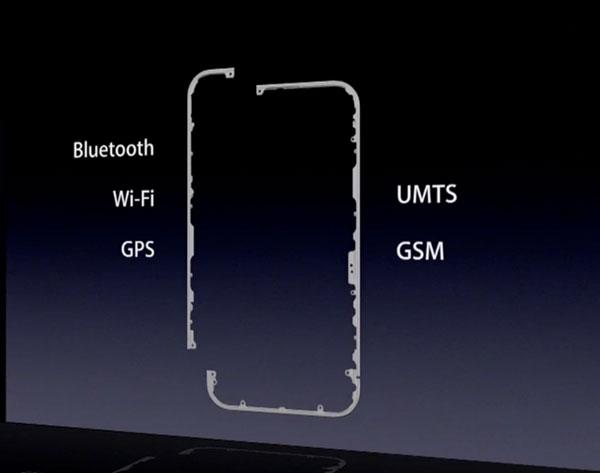The images, published by MacRumors and supplied by iPatchiPods, appear to show a unibody frame without case seams on the top or either side of the top of the phone.
Existing GSM iPhone 4 models sold by AT&T and other global carriers have a single seam on the top, while the Verizon CDMA model has two seams on either side of the top end.
The seams separate the external edge of the iPhone 4 into antenna segments; the GSM model has two antennas (one for mobile use and one for WiFi/Bluetooth/GPS, as shown below) while the CDMA model has three (dual mobile antennas required in the CDMA specification and a WiFi/Bluetooth/GPS segment).
The modified case (shown below from the front and flipped over on its back) also incorporates a SIM card, something that only the existing GSM version of the current iPhone 4 has or needs.
It's not yet known whether the anticipated new cheaper iPhone 4 (sometimes referred to as the "iPhone 4S") will be dual band, allowing it to work on both major mobile network types. It is expected that the separate iPhone 5 model, bearing an original new design, will support both networks.
The primary feature of the new iPhone 4 phone design is expected to be its reduced cost, achieved through the use of streamlined components and a smaller 8GB of storage capacity.
A similarly purported "iPhone 5" prototype case design appeared in January, similarly lacking seams on the top two sides, instead bearing a single seam on the top.
The report also portrays a bottom frame segment (below) that appears to lack a defined Home button, suggesting that Apple may change the appearance and design of the Home button on the phones it releases later this fall.
 Daniel Eran Dilger
Daniel Eran Dilger






-m.jpg)



 Andrew Orr
Andrew Orr
 Malcolm Owen
Malcolm Owen
 Marko Zivkovic
Marko Zivkovic

 Andrew O'Hara
Andrew O'Hara
 William Gallagher
William Gallagher









14 Comments
Brillant!
Surely this is fake¡ Apple won't make the same mistake twice with the antenna¡
Apple has sold 69 million iPhones since June of last year.
I'm pretty sure most of them were the iPhone 4... "broken" antenna and all.
In short... "Antennagate" was silly.
In short... "Antennagate" was silly.
To me, the name "Antennagate" refers to the conspiracy created to make people believe the antennas were faulty, not some sort of cover-up of truly faulty antennas. Because there really weren't any.
Exactly.